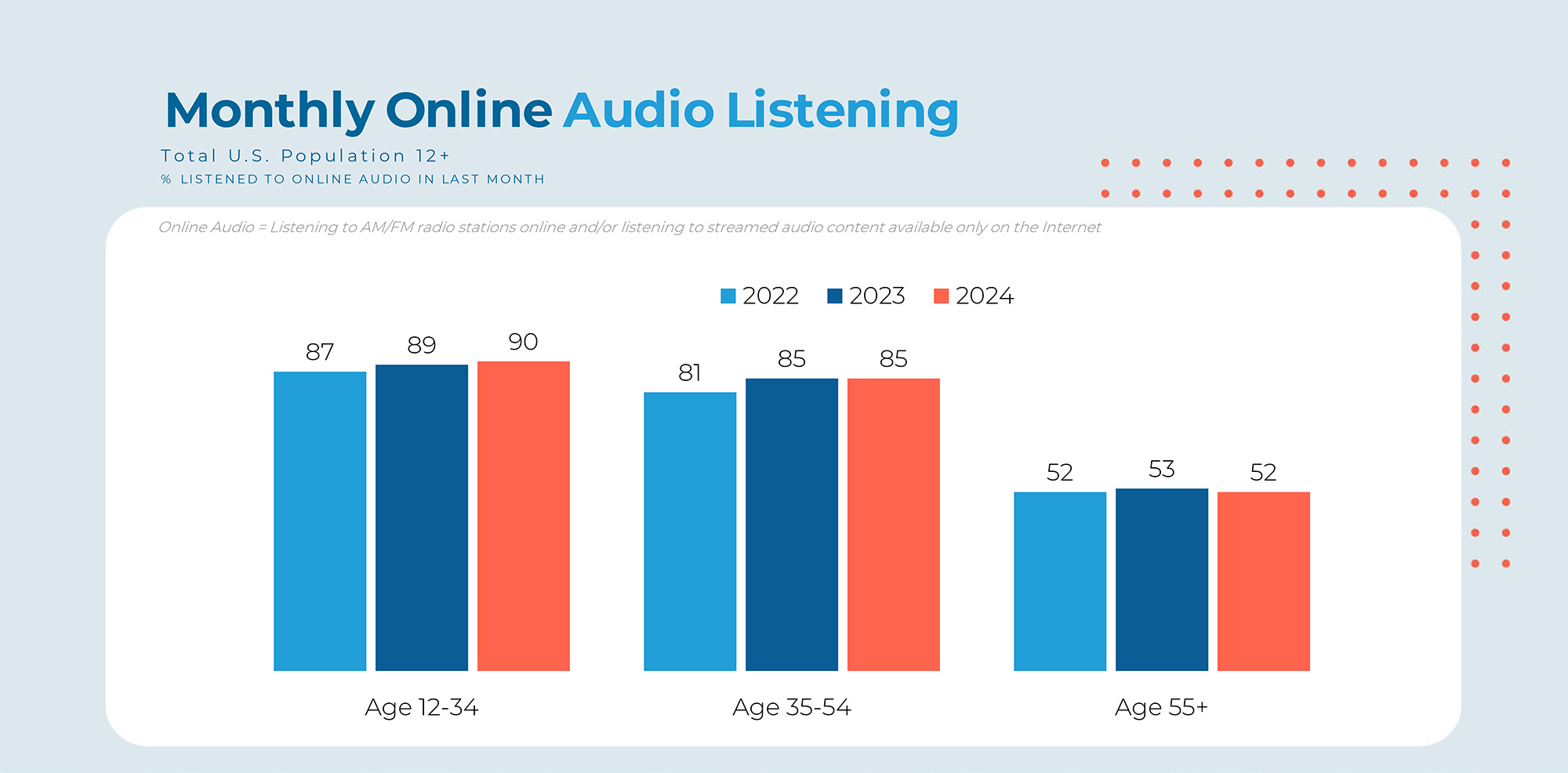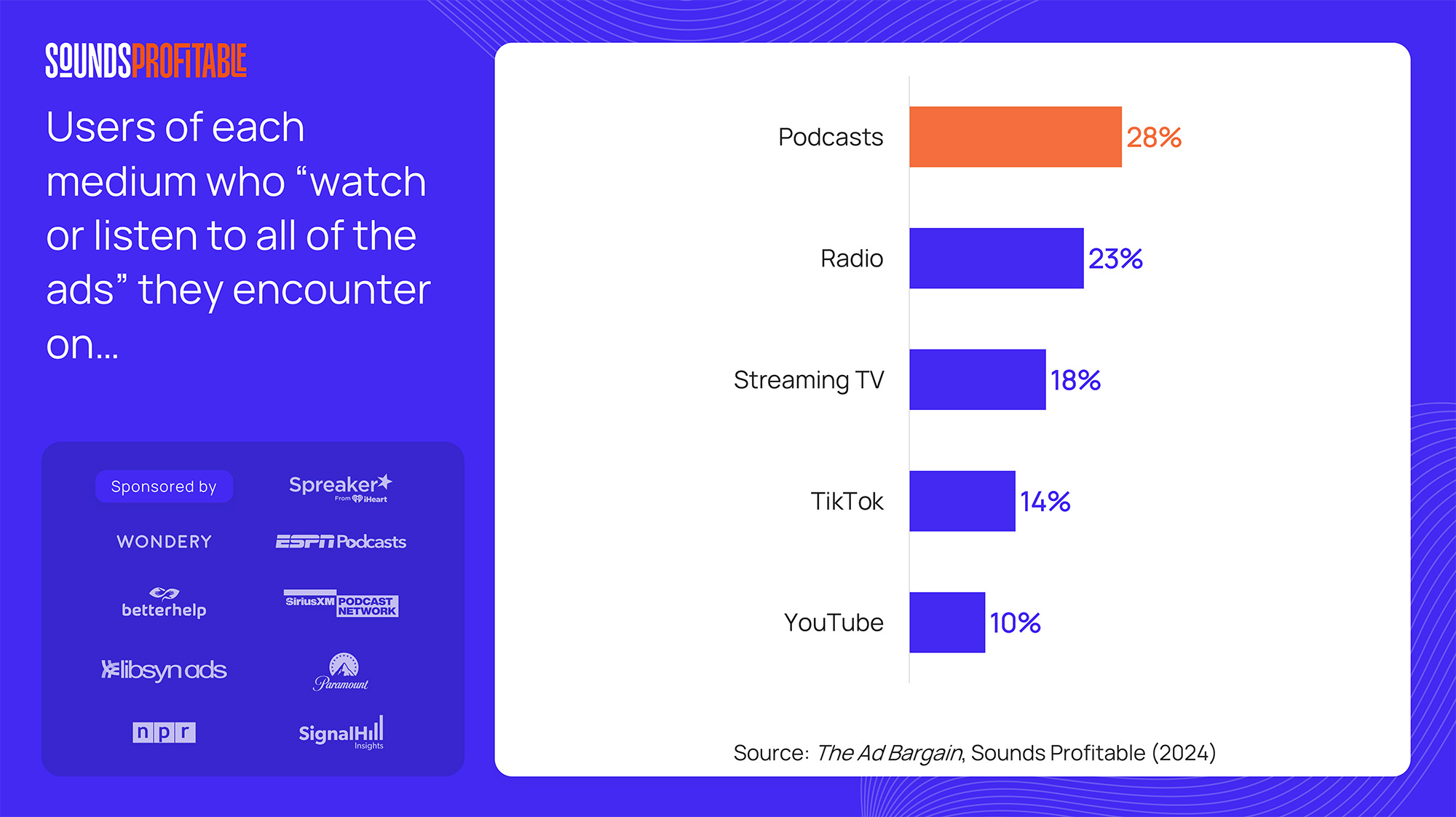More than 15 years ago, we extolled the benefits of using radio to market to Baby Boomers. Back then, we warned that very soon traditional radio wouldn’t be the only game in town. Well, the era of audio marketing is upon us. With increasingly tech-savvy seniors, audio-based advertising can be a smart addition to your integrated marketing strategy. For those marketing to Baby Boomers and beyond, the (no longer new) medium of radio is still an incredibly effective way to reach a targeted older audience.
Radio: Are Boomers listening?
How has traditional AM/FM radio fared in this new age of audio marketing? Quite well, actually. According to research from Edison and NPR, Americans ages 55+ spend an average of 3 hours and 39 minutes a day listening to audio, with 56% of that time tuned to traditional AM/FM radio. That’s significantly more time than younger age groups: Those ages 13–54 only spend about 30% of listening time with terrestrial radio.
Share of time spent listening among 55+ Americans
Source: Hit Play, Boomer! report
%
AM/FM Radio
%
Sirius Radio
%
Streaming Audio
%
Owned Music
%
YouTube
%
Podcasts
%
Other
Radio reaches nearly 84% of people ages 55+ and 82% of those 65+ — the highest reach for any age group.
Classical, adult standards, jazz and news/talk formats are especially appealing to those ages 65+, with the share of listeners ranging from about 40 to 50% in each of those formats. Interestingly, consumers ages 55–64 are much less concentrated, listening to a wider variety of formats, with only classic rock just barely breaking 30%:
top formats among listeners ages 55-64

Source: MRI Simmons 2024 Spring Doublebase
What’s more, radio listeners are affluent: According to Katz Radio Group, Classical and All News listeners have a higher average net worth than any measured TV, magazine or newspaper audience.
Radio has also been smart — traditional radio stations are also in the digital game by offering their broadcasts via the web. That means the audience can follow them from the car to their home or office and back to the car, which means your messages will follow, too. Edison Research’s Infinite Dial report — the longest-running survey of digital media consumer behavior in America — found that 52% of adults 55+ listened online in 2024, which has been holding steady since 2022 and up significantly since we reported on this trend in 2018, when the percentage was 33%.

Source: Edison Research’s Infinite Dial report
Also consider that consumer trust in advertising differs across channels. As a legacy platform, radio still commands the highest share of collective trust in advertising. According to Nielsen, 51% of 50+ adults consider radio spots very or somewhat trustworthy. Compare that to social media, where only 25% of 50+ adults consider ads to be very or somewhat trustworthy — in other words, 50+ consumers consider radio ads to be more than twice as trustworthy as social media ads.
Katz Radio Group found the same: 8 in 10 consumers consider radio to be trustworthy or very trustworthy and 3x more trustworthy than social media. In another Katz survey, 82% of 55+ adults considered radio to be trustworthy, compared to only 19% for social media. More than three-quarters of listeners (77%) would try a brand or product endorsed by their favorite radio personality.
Beyond radio: Audio marketing for Baby Boomers
Audio marketing = radio marketing for the modern age. It’s still capturing your audience through dynamic auditory ad spots, but the devices and programs on which these ads can be heard are more plentiful. Audio marketing gives you the opportunity to better target older adults based on their preferences for certain delivery mechanisms or even specific programs. Basically, with the advent of podcasts, streaming radio services like Pandora and Spotify and smart speakers like Amazon Alexa or Google Home, your marketing choices have significantly expanded beyond the AM/FM dial.
According to the Infinite Dial report, 27% of those ages 55+ listen to podcasts monthly, up from 22% in 2022 and 17% in 2019. For senior living providers exploring ways to market to adult children, a podcast may be effective: 55% of those ages 35–54 listen monthly, up from 43% in 2022.
But why choose to advertise during a podcast? As more of us expect our media to be delivered on demand, podcasts have emerged as a low-cost, convenient and accessible form of entertainment. You can decide which shows to place ads in to stand out to your audience, and podcasts are hosted across multiple platforms and devices. That means it’s easier than ever to reach a wide swathe of people, increasing your overall brand awareness. Plus, tracking capabilities make it possible to track effectiveness.
It also seems that as more consumers listen to free, streaming media, they know that advertisements are a part of using these services. Research has shown that most people don’t mind various types of ads: 43% of 50+ podcast listeners say they enjoy or don’t mind podcast ads, according to the Ad Nauseum report, a survey of 1,000 weekly podcast listeners. And 68% of listeners tuned in to some, most or all of the ads. So don’t be afraid that your ads will be skipped or ignored! In fact, podcasts outperform both radio and streaming TV for users who engage with ads.

Source: Ad Nauseum report
Why? A few reasons are likely. First, podcast topics tend to be niche, with ads that are relevant to their niche audience. Second, like radio personalities, people tend to develop a personal affinity toward the podcast host and the trust placed in the host infers trust in the advertiser, particularly when the spot is host-read.
Capture your Boomer audience
To capture your target audience, think beyond the airwaves and discover where and how your prospects are listening to audio content. Evaluate whether testing a new medium in addition to traditional radio makes sense as part of your comprehensive integrated marketing strategy.



